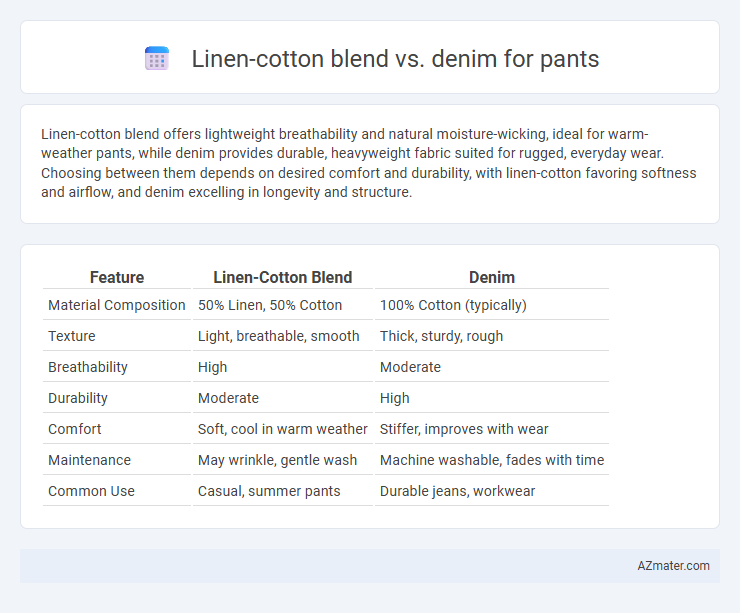Linen-cotton blend offers lightweight breathability and natural moisture-wicking, ideal for warm-weather pants, while denim provides durable, heavyweight fabric suited for rugged, everyday wear. Choosing between them depends on desired comfort and durability, with linen-cotton favoring softness and airflow, and denim excelling in longevity and structure.
Table of Comparison
| Feature | Linen-Cotton Blend | Denim |
|---|---|---|
| Material Composition | 50% Linen, 50% Cotton | 100% Cotton (typically) |
| Texture | Light, breathable, smooth | Thick, sturdy, rough |
| Breathability | High | Moderate |
| Durability | Moderate | High |
| Comfort | Soft, cool in warm weather | Stiffer, improves with wear |
| Maintenance | May wrinkle, gentle wash | Machine washable, fades with time |
| Common Use | Casual, summer pants | Durable jeans, workwear |
Introduction to Linen-Cotton Blend and Denim
Linen-cotton blend fabric combines the breathability and lightweight texture of linen with the softness and durability of cotton, making it ideal for comfortable, versatile pants suitable for warmer climates. Denim, a sturdy cotton twill textile known for its durability and ruggedness, is traditionally used for casual and workwear pants, offering longevity and resistance to wear. Choosing between linen-cotton blend and denim depends on the desired balance between comfort, breathability, and durability in pant materials.
Fabric Composition and Structure
Linen-cotton blend pants combine natural flax fibers with soft cotton, resulting in a lightweight, breathable fabric ideal for warm weather due to its moisture-wicking and quick-drying properties. Denim, primarily made from 100% cotton using a twill weave, offers a heavier, durable texture with a distinct diagonal ribbing that enhances strength and abrasion resistance. The linen-cotton blend provides a softer, more flexible feel with less stiffness compared to denim's robust, structured composition suitable for rugged wear.
Comfort and Breathability Comparison
Linen-cotton blend pants provide superior breathability and lightweight comfort due to the natural fibers allowing better air circulation, making them ideal for warm weather. Denim, typically made from heavier cotton twill, offers durability but tends to trap heat and retain moisture, resulting in reduced breathability and less comfort in hot conditions. Choosing linen-cotton blend pants enhances overall comfort through moisture-wicking properties and softness, while denim excels in sturdiness but sacrifices ventilation.
Durability and Longevity
Linen-cotton blend pants offer moderate durability with natural fibers that provide breathability and comfort but may be prone to wear and tear over time. Denim, composed primarily of tightly woven cotton twill, is known for its exceptional durability and resistance to abrasion, making it a preferred choice for long-lasting pants. The longevity of denim exceeds that of linen-cotton blends due to its robust fiber structure and ability to maintain shape after repeated washing and heavy use.
Style and Aesthetics
Linen-cotton blend pants offer a lightweight, breathable fabric with a natural texture that exudes effortless elegance and casual sophistication, making them ideal for warm-weather style and relaxed yet polished looks. Denim pants showcase a rugged, durable aesthetic characterized by its classic indigo dye and structured fit, providing versatile options from casual streetwear to vintage-inspired fashion. Choosing between the two hinges on the desired style: linen-cotton blends emphasize comfort and refined simplicity, while denim delivers timeless, bold edge and durability.
Seasonal Suitability
Linen-cotton blend pants offer superior breathability and moisture-wicking properties, making them ideal for warm and humid seasons, as they keep the wearer cool and comfortable. Denim pants, with their dense weave and heavier weight, provide better insulation and durability, fitting colder or transitional weather when warmth and toughness are priorities. Choosing between these fabrics depends on seasonal demands: lightweight linen-cotton excels in summer, while denim is practical for fall and winter wear.
Maintenance and Care Requirements
Linen-cotton blend pants require gentle washing in cold water to prevent shrinking and maintain fabric softness, often benefiting from air drying to avoid damage from high heat. Denim pants are more durable, thriving with machine washing inside out and occasional tumble drying, but may fade or stiffen if exposed to frequent high temperature washes. Proper maintenance for linen-cotton blend focuses on preserving breathability and texture, while denim care emphasizes retaining color and structural integrity over time.
Eco-Friendliness and Sustainability
Linen-cotton blend pants offer superior eco-friendliness due to natural fibers that require less water and pesticides compared to conventional cotton or denim production. Denim, primarily made from cotton, often involves intensive water use and chemical treatments, raising environmental concerns in its manufacturing process. Choosing linen-cotton blends supports sustainable fashion by reducing resource consumption and promoting biodegradable materials.
Cost and Affordability
Linen-cotton blend pants generally offer a more affordable price point compared to denim, making them a budget-friendly option for warm-weather wardrobes. Denim pants tend to be pricier due to their durability and the additional processing required for different washes and finishes. Choosing linen-cotton blend can reduce overall costs while maintaining breathability and comfort, ideal for cost-conscious shoppers seeking lightweight fabric.
Choosing the Right Fabric for Your Pants
Linen-cotton blend offers breathability and lightweight comfort, making it ideal for warm climates and casual wear, while denim provides durability and a structured fit suited for rugged use and cooler weather. Choosing the right fabric depends on your lifestyle needs, such as ease of movement, maintenance, and temperature regulation. Prioritize linen-cotton for soft texture and moisture-wicking properties, or denim for long-lasting strength and classic style.

Infographic: Linen-cotton blend vs Denim for Pant
 azmater.com
azmater.com